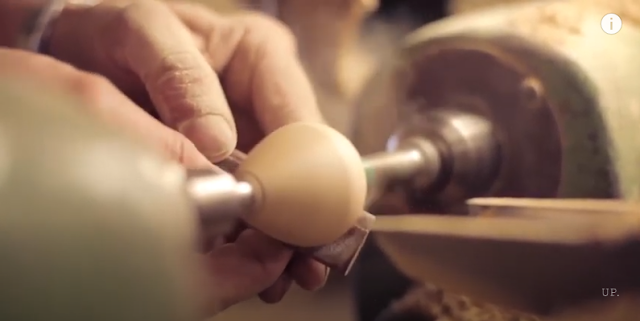Whilst watching The School of Life, Alain de Botton eloquently explains, ‘Why we hate cheap things.’ “The answer lies in the mind of a 4 year old” and continues, “One buys them a £49.00 wooden toy made by Danish artisans and finds that they prefer the cardboard box that it came in.” Please note the video does not conclude there. At midway point I felt a spark of interest to pursue the allure of Danish wooden toys; to learn about their creators and their design history.
I think there's a surge of appreciation for children’s toys that are sustainable; additionally the toys have a nostalgic value appealing to people who appreciate classic Danish design. Mid-century modern design is a much esteemed international design style; often modern twists are added with new pieces from contemporary designers such as Johnathan Adler, known for ceramics and home furnishings. Danish toy designer Kay Bojesen’s quotes, “We are sliding into a time of simplification where the practical design of everyday things will be an important demand to consider.” These toys are extremely well made to exacting design standards and have been popular since their conception; Kay Bojesen took an interest in his son’s education and identified children’s need to play. And so he designed building bricks, cars with layout tracks and every conceivable animal imaginable; as toys they interact together. An example of this is seen on the b/w poster. The monkey is posed as a teacher with a class of little bears at desks, though they are inanimate objects they are composed in a most animated state. There’s a twist to his toy designs, they have human traits; he had a delightfully playful approach to design.
Kay Bojesen (15 August 1886 – 28 August 1958) the designer of the iconic monkey firstly trained as a Grocer, he was an entrepreneur as well an inquisitive minded creative. Initially his work was in the style of Art Nouveau, likely due to Georg Jensen’s influence, a Danish Silversmith whom he later trained with. In 1922 he began making wooden toys for his young son. By the late 1920’s he was making the toys available to people from all levels in society. Due to the popularity the creator founded a shop in 1932 and specialized in making a range of these hand tooled wooden toys. They were no more than 6 to10 inches tall. In 1950 he designed the jointed monkey that twists and turns in varied multifarious amusing ways that could hang suspended from either hands or feet, and had the most ridiculously naïve facial expression. He first came to the British public’s attention in an exhibition at the V&A. He has been celebrated as an honorary member of the National Association of Danish Arts and Crafts. After his wife died in 1990, Danish design house Rosendahl bought the rights to the toys, and continues with production today.
Kristian Vedel (March 2, 1923 - March 5, 2003) is the creator of the bird. During his lifetime he was predominantly known as Danish industrial designer and part of the Scandinavian Design movement. At the Royal Academy of Fine Arts in Copenhagen he was under the tutor ledge of Kaare Klint, the father of modern Danish furniture design, he was also influenced by the German Bauhaus school. He was known to produce pieces that had functionality combined with a creative sense of use of materials. Producing multi award winning designs. He designed the bird that is rather ingenious in its design. As it appears so simple in two parts head and body with free movement, the head tilting in any direction. “Created as a family, Bird can express happiness, sadness and curiosity, living alone or together as a family.” Quotes Architectmade and continues with the production of this design.
Morten Jensen CEO of Architectmade states, “We want to be part of pushing the general public away from the use and throw away culture.” Their collection includes Hans Bølling duck/duckling and Oscar and Bobby and Rufus from 1959 with more recent toys designed by Lars Beller Fjectland Kin family and Nikolaj Klitgaard Bubo Owls 2003 to name a few (see link below). This has given the company more flexibility to expand their range with contemporary Danish designers. However, only Kristian Vedel’s bird toys are still made in Denmark.Does it really matter that Architectmade toys are now made in China? Morten Jensen, says “China is eager to learn about the quality and level of work of traditional Danish craftsmanship.” and continues, “The key to the wooden toys is although the products are handmade you should not be able to see that they are handmade. This is the perfection level both brands strive to achieve.” China has great respect for Danish design. They are using traditional methods of hand tooling, working in collaboration with the companies exacting standards.
The Rosendahl design group states, “Innovation, creative joy and respect for Danish design tradition – Our ambition is to profile and protect Danish design treasures by rediscovering classics – as well as creating new ones in keeping with Danish design tradition. The common denominator is products that make every day more beautiful and add value for our customers.”
As Graphic designer Paul Rand once wisely said, “Good design is good business.” Sustainability in the design industry is a huge environmental issue; perhaps the toys are more costly to these businesses using traditional production methods, but to the consumer only in the short term. I hope this answers the question, ‘Why we hate cheap things’. You never want to throw away these artisan toys they are passed down through generations. Overall good design brings us joy and therein lies its value.

















No comments:
Post a Comment